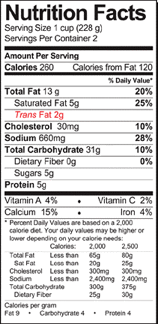Making Sense of The Nutrition Label
Understanding how to read a nutrition label is fundamentally important, especially for people with type-2 diabetes. Nutrition labels, regulated by the Food and Drug Administration (FDA), help consumers make informed choices and are required for nearly all packaged food items. While nutrition labels are meant to be a helpful tool, they often leave the consumer scratching their head! The FDA has recently proposed changes that would make nutrition labels easier to interpret. Such changes include a new design that would make calories and serving size more prominent. Until these changes are finalized, read on for some easy tips on how to make sense of the current nutrition label.

- First things first: Start with the serving size. All the information on a nutrition label is based on a single serving. The serving size is often given in a cup or measuring spoon measurement. Weight is also listed in parenthesis next the serving size. Weight is useful if you are using a food scale.
- Servings per container: The number of servings in the box, package, container, etc. This is helpful when looking at a food that might appear to be a single serving but really is 2 to 3 servings.
- Calories measure how much energy a food provides. Weight gain results when more calories are consumed than the body can use. Being overweight or obese increases the risk for high blood pressure, heart disease, and diabetes.
- The Percent Daily Values are based on the Daily Value recommendations for key nutrients for a 2,000-calorie diet. For an estimation of your daily calorie needs visit: https://www.SuperTracker.usda.gov/createprofile.aspx
- Fat: Dietary Guidelines recommend a fat intake of 20-35% of total calories each day. Fat in food comes from monounsaturated, polyunsaturated, saturated, and trans fat in varying amounts. Saturated and trans fat are two of the main dietary factors that raise blood cholesterol.
- Dietary Guidelines for Americans, 2010 recommends consuming less than 10% of calories from saturated fat. Sources include whole milk, cream, ice cream, whole-milk cheeses, butter, lard, meats, palm kernel, and coconut oils.
- Trans fat intake should be kept as low as possible. Sources include cookies, crackers, French-fries, and baked goods, as well as foods with partially hydrogenated oils in the ingredient list.
- Cholesterol: Dietary Guidelines for Americans, 2010 recommends that cholesterol intake not exceed 300mg per day.
- Sodium can raise blood pressure in salt sensitive people. Guidelines recommend sodium intakes not exceed 2,300mg per day. Canned foods, frozen dinners, and snack food items are typically high in sodium.
- Low sodium: 140mg or less per serving
- Moderate sodium: 140-500mg per serving
- Higher sodium: greater than 500mg per serving
- Carbohydrates are the body’s primary energy source and should make up 45-65% of a person’s daily caloric intake.
- Total carbohydrate amount shown on a nutrition label includes starch, sugar and fiber. One carbohydrate serving is equal to 15 grams of carbohydrates. Many people do well with eating 45-60 grams (3-4 carbohydrate servings) of carbohydrates at each meal. The recommended daily allowance for carbohydrates is 130 grams per day.
- Fiber has been shown to help lower blood cholesterol and improve bowel regularity and blood glucose control. The recommended dietary fiber intake is 14 grams per 1,000 calories consumed. Select whole grains (bread/pasta), fresh fruits, vegetables, beans, and legumes to reach your daily fiber needs. A good rule of thumb is to choose foods that have at least 3 grams fiber per serving.
- Fiber is a non-digestible form of carbohydrate. If a food has more than 5 grams of fiber per serving you can deduct half that amount from the total carbohydrate amount.
- Sugar on the food label includes both added and natural sugars. Sugar consumption should not exceed 10-12 teaspoons (40-48 grams) per day. Common sweeteners include sucrose, high fructose corn syrup, brown sugar, raw sugar, corn sweetener, and molasses. Quick Tip: When choosing foods such as cereal or granola bars, select the products in which the sugar amount in less than half the total carbohydrate amount.
- Protein should make up 10-15% of total caloric intake.
- Protein sources include animal (meat/poultry/fish/eggs/dairy) and plants (beans/legumes/nuts/tofu). Choosing lean cuts of meat, low fat dairy, and plant sources can prevent excess intake of calories and saturated fat.
- The American Heart Association recommends eating fish twice per week. Salmon, trout, and herring are high in Omega 3 fatty acids and may reduce the risk of cardiovascular disease. Lean cuts of poultry include white meat without skin, chicken breast and ground turkey. When selecting beef, look for words such as “round” and “loin.” These generally indicate a leaner cut (i.e. tenderloin, sirloin).
Bottom Line: Having a better understanding of how to interpret a nutrition label can be a great start to improving your overall health!

Join the conversation